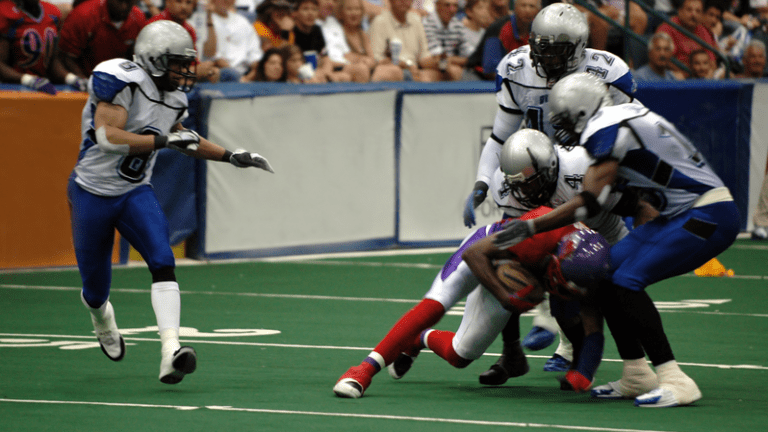Every defender yearns for the opportunity to make that big hit that brings the crowd to their feet. The helmet and pad contact can sound like thunder on the field and send shockwaves throughout the stadium. That monster of a tackle ignites the team and generates a momentum shift, yet, all defensive coordinators primarily want one thing- a made tackle!
Going for the big hit can compromise form and jeopardize the tackle, naturally going against the purpose of the defense; stopping the offense.
Follow these three basic rules in order to master form tackling.
Rule #1: Widen Your Base
Before every tackle, you should lower your base, which means to sink your hips, dropping your rear. Your legs should be a little more than shoulder width apart and your neck muscles should tighten.
A wider base provides the athlete with a needed balance, and the potential for power is at its greatest in this position.
Rule #2: Power Step
When I teach tackling, I use the phrase, “To ’em and thru ’em!” That means you have to take an explosive power step towards the ball carrier in order to set up the contact. The power step prevents arm tackling and diving because the defender puts himself in the best position to make the tackle with this move. Ideally, the defender would step in front of the ball carrier, attacking the center of the chest or the numbers on the jersey. An effective power step cuts off the offensive player, leaving them with no where to go.
Rule #3: Takedown
You’ve widened your base and cut the defender off by taking a power step towards the middle of their chest. The only thing left to do is bring them down. “To ’em” is the power step and “thru ’em” is the takedown. After you have cut the offensive player off and aimed at their chest, tighten the neck, keeping the head up and rip both hands upward and around the ball carrier. In the one fluid motion, wrap up the offensive player and continue to pump your legs. The momentum you created should drive the offense backwards into the dirt.
Keep in mind two important aspects of tackling that are too often problematic for defenders: not wrapping up and dropping or leading with the head.
The loud thumping hit is impressive, but it means nothing if the offensive player continues to run after contact. Ball carriers are trained to absorb hits and keep their legs moving. If you do not follow through with the takedown, the offensive person will continue to move down the field. Leading with or dropping your head to tackle is a dangerous practice that can result in missed tackles or head and neck injuries. When you drop your head to make a tackle, you lose sight of the defender; you should always prepare for a tackle by widening your base and sinking your hips. In addition, leading your head to tackle means that your head and neck will take the brunt of the impact instead of your shoulder pads, torso and lower body.
CoachUp is the safest and easiest way to find a coach for personalized training. With our 100% money-back guarantee and vetted coaches, anyone can achieve their full athletic potential. Find your perfect coach today and become the athlete you want to be!
How useful was this post?
Click on a star to rate it!
Average rating 0 / 5. Vote count: 0
No votes so far! Be the first to rate this post.



